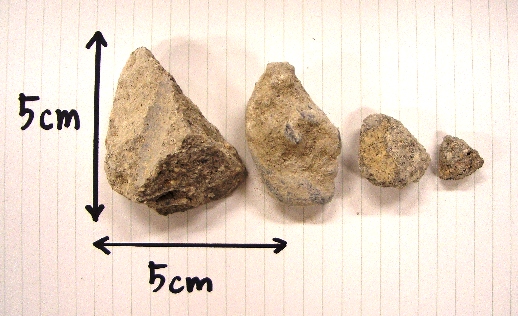The environmental sustainability of the subsurface should be maintained for a long period of time since it is crucial for life and society. This laboratory mainly focuses on the study of recycling technologies of various wastes as geo-materials, on remediation technologies for contaminated lands, and on proper containment and management of hazardous materials.
The main research topics are detailed below.
Research Area - Environmentally-Friendly Infrastructures -
Ground contamination
When selecting adequate techniques to solve soil and/or groundwater contamination problems, the mobility of the contaminants, their mechanisms, and the reliability of the countermeasures should be scientifically clarified. In this laboratory, the mobility of heavy metals and VOCs and their effective countermeasures, such as remediation and containment techniques, are experimentally and analytically studied. In addition, the quantification of the environmental impacts and that of the effectiveness of the countermeasures are calculated using the environmental risk assessment method to contribute to the adequate communication of risks.
 |
 |
| Evaluating transport of NAPLs in the ground | Hydraulic conductivity tests on barrier materials |
Publications
Flores, G., Katsumi, T., Eua-Apiwatch, S., Lautua, S., and Inui, T. (2016): Migration of different LNAPLs in subsurface under groundwater fluctuating conditions by the simplified image analysis method, Journal of Geo-engineering Sciences, Vol.3, No.1, pp.15-30.
Inui, T., Katsumi, T., and Takai, A. (2016): Cesium sorption/desorption characteristics of sodium bentonite affected by major cations in leachate from MSW incinerator ash, Japanese Geotechnical Society Special Publication, Vol.2, pp.1841-1844.
Takai, A., Inui, T., and Katsumi, T. (2016): Evaluating the hydraulic barrier performance of soil-bentonite cutoff walls using the piezocone penetration test, Soils and Foundations, JGS, Vol.56, Issue 2, JGS, pp.277-290.
Environmental impact of recycled materials
The social and economic system is now shifting to promote further resource recycling and the maintenance of existing infrastructures with local participation, in order to attain a sustainable development. Furthermore, environmental problems are being exacerbated by climate change, which can also trigger various ground disasters. In this laboratory, new concepts for infrastructure improvement are studied considering such global environmental problems as the application of recycled wastes as geo-materials, and the realization of the more environmentally-friendly construction and maintenance of infrastructures..
 |
 |
| Geoenvironmental impact of recycled materials | Materials recycled from waste concrete |
Publications
Naka, A. et al. (2016): Column percolation test for contaminated soils: Key factors for standardization, Journal of Hazardous Materials, Elsevier Vol.320, No.15, pp.326-340.
Tang, Q., Kim, H., Endo, K., Katsumi, T., and Inui, T. (2015): Size effect on lysimeter test evaluating the properties of construction and demolition waste leachate, Soils and Foundations, Vol.55, Issue 4, pp.720-736.
Katsumi, T. (2015): Soil excavation and reclamation in civil engineering: Environmental aspects, Soil Science and Plant Nutrition, Taylor & Francis, Vol.61, No.S1, pp.21-29.
Proper Waste Disposal
In order to build a recycling-based society, the 3R principle (Reduce, Reuse and Recycle) should be a strong driver of our life. Unfortunatelly, certain amount of wastes that are technically and economically difficult to recycle is going to be generated. Hence, to properly dispose such wastes to landfill sites so that we can use the land after post-closure is a reasonable solution. In this laboratory, a series of studies related to the construction, management, and utilization of waste landfill sites are performed including the geotechnical evaluation of construction materials, the mobility assessment of toxic elements in the sites, and the risk assessment of the utilization of closed landfill sites.
 |
 |
| Differential settlement under GCLs | Construction risks on closed landfill sites |
Publications
Katsumi, T., Inui, T., Takai, A., Oshima, H., and Flores, G. (2015): Geotechnics for land use at coastal landfills, Proceedings of the XVI ESCMGE - Geotechnical Engineering for Infrastructure and Development, ICE Publishing, pp.2711-2716.
Nguyen, L.C., Inui, T., Ikeda, K., and Katsumi, T. (2015): Aging effects on the mechanical property of waste mixtures in coastal landfill sites, Soils and Foundations, JGS, Vol.55, Issue 6, pp.1441-1453.p>
Plata, H., Inui, T., Katsumi, T., Oya, Y., and Kamon, M. (2010): Speciation and mobility of Zinc in coastal landfill sites with MSW incinerator ash, Journal of Environmental Engineering, ASCE, Vol.136, No.8, pp.762-768.
Recovery from huge disasters
The 2011 off the Pacific Coast of Tohoku Earthquake in 2011 gave many lessons regarding geotechnical and geoenvironmental issues that must be passed down for generations. In this laboratory, sophistication of disaster waste treatment system using ICT data, recovery of soils from disaster waste as geo-material, and reasonable disposal of soils and wastes containing nuclides are being studied to contribute to the recovery of Tohoku area, and to future disasters.
 |
 |
| Tsunami deposits in coastal area | Embankment using recovered soil |
Publications
Katsumi, T., Okawara, M., Kawashima, M., Endo, K., Sakanakura, H., Iwashita, S., Takai, A., and Inui, T. (2017): Soils recovered from disaster debris . Characterization and utilization ., Journal of JSCE, Vol.5, No.1, pp.145-156.
Inui, T., Yasutaka, T., Endo, K. and Katsumi, T. (2013): Geo-environmental issues induced by the 2011 off the Pacific Coast of Tohoku Earthquake and tsunami, Soils and Foundations, Vol. 52, Issue 5, pp. 856-871.
Takai, A., Endo, K., Yasutaka, T., Inui, T., and Katsumi, T. (2013): Characterization of tsunami deposits toward utilization followed by the 2011 East Japan Earthquake and tsunami, Proceedings of Congres GESeD (Gestion Environnementale des Sediments de Dragage), O21 (on CD)






